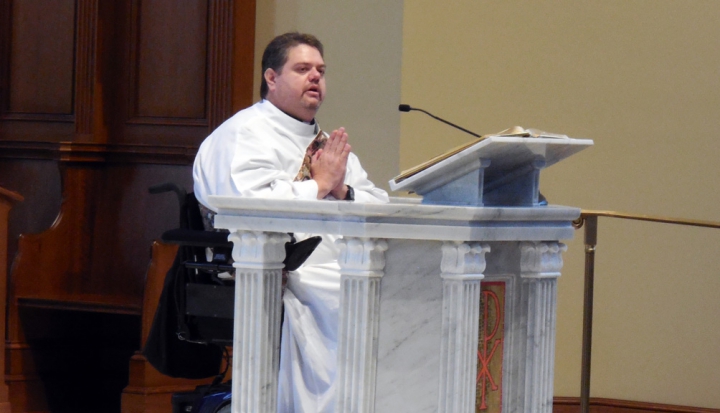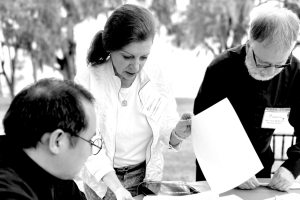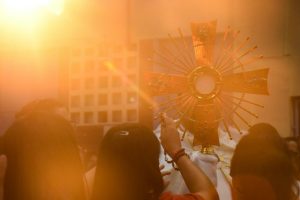Despite a few stellar examples, many parishes have a long way to go to make sure all people can literally get in the door.
Jane Bittle is an active leader at All Saints Parish in Dallas, Texas. She sings in the choir, cantors weddings and funerals, and participates in women’s prayer groups and retreats. She is also a member of her church’s Ministry to Persons with Disabilities and Caregivers, which she was invited to cofound following an initiative by the Dallas diocese to increase ministries for Catholics with disabilities. Whether she’s sponsoring a person who uses a wheelchair in RCIA or making sure that hard-of-hearing parishioners have access to sound system headphones, Bittle, who is blind herself, is working to make sure that parishioners with physical impairments are able to fully access all of what their parishes have to offer.
“If you only come to church, and you just sit in the pew and you don’t get involved, church will be a very hollow experience for you. The sign of peace is wonderful, but it’s just not enough,” says Bittle, who also worked for many years as a social worker to the sick and disabled. “We don’t live in a white-bread, sparkling clean, able-bodied society. The job of our church is to take whoever comes to us, so it’s my job to show up.”
Though the days of overt discrimination and hostility toward people with disabilities are mostly gone—unlike President Franklin Roosevelt, political candidates such as Greg Abbott of Texas and Tammy Duckworth of Illinois see their wheelchairs as assets—significant attention must be paid so that parish life is accessible to those with differing abilities. People with disabilities want to contribute to their church communities, to build strong social networks, and to realize their full potential as loving Christians. This can happen only when barriers to participation are removed at the most basic physical levels.
In Emmaus, Pennsylvania, Dorothy Dwyer takes a role similar to Bittle’s at the parish of St. Ann. Dwyer first became an enterprising volunteer at the age of 33, shortly after being diagnosed with multiple sclerosis (MS). At the time the Pennsylvanian mother of four, now 80, knew little about the disease. Her neurologist told her that the good news was that she was very young to have MS and that she should get on with her life. Dwyer immersed herself in activity, joining an adaptive swim team and becoming a leader for her sons’ Cub Scout and Boy Scout troops.
She then became involved at St. Ann’s, where she has served as a lector and actively campaigned for the installation of railings, ramps, and wheelchair-accessible parking spaces. Commissioned by Mercy Sister Janice Marie Johnson at the Allentown, Pennsylvania diocesan office to serve parishioners with disabilities, Dwyer reaches out to new members of St. Ann’s who have physical or developmental impairments and gets them involved in ministries and social events. She is quick to remind fellow parishioners who, like her, have been diagnosed with MS, that “it’s not the end of the world,” and helps them find activities that fit their physical capabilities.
Dwyer, who walks with a cane, feels that staying active at St. Ann’s has been crucial to helping her fight MS and to live a long and fruitful life. Her understanding of the spiritual value of involvement and inclusion in a community reflects the modern Catholic approach to disability.
Taking the first steps
The vital role that people with physical and developmental disabilities play throughout the gospels is obvious: They are the most frequent recipients of Christ’s miracles. As the U.S. Catholic bishops wrote in their 1978 Pastoral Statement on Persons with Disabilities, “The central meaning of Jesus’ ministry is bound up with the fact that he sought the company of people who, for one reason or another, were forced to live on the fringe of society.”
The American Catholic Church has had varying responses to the concerns of people with disabilities over the course of its history, building institutions for the disabled run by religious orders in the 19th century, then calling for authentic inclusion and leadership roles for disabled Catholics in the 1970s, and founding the National Catholic Partnership on Disability (NCPD) in 1982.
While it can be easy to see the need for physical renovations, such as a ramp or an elevator to allow people to enter a church building, it’s up to the parish to decide whether it is necessary to, for example, lower a holy water font or to purchase a $1,200 sound system for the hearing impaired. Nearly one in five Americans has some form of disability, and many people naturally join this group as they grow older and experience loss of vision, hearing, or mobility, so the need for accessibility can end up benefitting many members of the parish.
One way many diocesan offices try to assess their community’s needs is to send out accessibility surveys, which require parishes to record every physical amendment they have made to become more accessible to churchgoers with disabilities. Once needs are known, initiatives are often started by disabled parishioners themselves, by their friends, or by a priest.
Atlanta Auxiliary Bishop David Talley, former pastor of St. John Neumann Parish outside Atlanta, and Dennis Kelly, leader of Catholic Construction Services for the Atlanta archdiocese, saw immense potential in the construction of an overtly physically inclusive church. They hired artist Dale Molnar to help them design a building that was accessible down to the last detail, from six different floor tiles that help sight-impaired parishioners navigate various parts of the church, to wheelchair spaces integrated throughout the pews, to chalices with special grips for people with arthritis.
For a church catering to the diverse and burgeoning Atlanta-area Catholic community, these obvious signs of welcome are important cultural symbols for the congregation. “In my opinion, there is increased participation week to week,” says Kelly. “The handicapped pews have people in them. [People] are more accepting, more open. It is a wonderful experience.”
Marilyn Scott and Dennis McNulty of the Diocese of Cleveland’s Catholic Charities Disability Services point to the tenacity of Father Joseph McNulty of St. Augustine’s, a low-income parish in Cleveland, in increasing the parish’s accessibility. Since his parishioners could not supply all the funds necessary to install an elevator and ramps in the church, McNulty campaigned for donations and grants over a period of years to afford the renovations. The parish now runs a diverse ministry including Mass in American Sign Language (ASL) with a deaf choir and a summer camp for children
with disabilities.
Likewise, Our Lady of the Assumption, the low-income Bronx parish where Father Robert Dunn celebrates Mass from his wheelchair every Sunday, offers a plethora of social events and ministries for parishioners of all abilities, including a wellness center that provides free medical consultations. Though the church was rebuilt in 1960 and is accessible, an extra ramp was added to the altar for the benefit of Dunn, who has MS.
“Someone may have an aunt or a cousin who uses a wheelchair,” says Dunn. “But when they see me up there, they have to realize in a concrete way that two steps can be the Grand Canyon.”
Often, as in the case of the Diocese of Allentown, Pennsylvania, a small initial outreach from the diocesan office, such as a bimonthly Mass in American Sign Language, raises awareness in the parishes. That can produce a flood of ministries and accessibility enhancements: Allentown now has weekly Masses in ASL at three different parishes, and 60 people serve the disabled in half of the 104 diocesan parishes.
Bumps in the road
Jane Bittle and the ministry at All Saints Parish have been successful in certain accessibility endeavors, such as encouraging the parish to make the church’s sanctuary wheelchair accessible and to install automatic doors on the entrance. But, Bittle notes sadly, the parish is reluctant to remove a piece of cabinetry beneath a sink in the community kitchen in order to make it easier for a person in a wheelchair to wash his or her hands.
When the Americans with Disabilities Act (ADA) was signed into law by President George H. W. Bush in 1990, religious groups lobbied for an exemption. As a result, there are still a number of old parish buildings, including Catholic schools, throughout the United States that are not wheelchair accessible and that do not have mechanisms for including those with hearing and sight impairments.
Under the ADA exemption, any older church that chooses to renovate for any reason must include and pay for measures to make the building accessible according to legal guidelines. Costs that will include not just a ramp but every other standard called for by the ADA frequently lead parishes to shy away from commissioning renovations.
Attitude and awareness, more so than high costs of renovation, are frequently the biggest obstacles to making accessibility improvements. Though All Saints is considered a model parish for the inclusion of disabled people in the Dallas diocese, Bittle says, “I get shined on, and our ministry has gotten shined on.” For Bittle, it is best to meet resistance head on. She recalls attempting to receive communion from a cardinal who was put off by her disability and hesitated to offer it to her, and another instance where a priest refused to offer the Eucharist to her twin sister, who is both blind and developmentally disabled.
Bittle has often needed to provide her own support. Most of the music she works on for church services she has to translate to Braille by herself. Growing up in California, Bittle attended mainstream schools from a young age. “I learned to interact with sighted people and explain to sighted people what I would need, how to go up to teachers on the first day of class to explain how I would take my test,” she says. “I’ve always had the attitude that if I want to do something, I just go and do it. But I don’t go to stations of the cross because the services are not in Braille. If I can’t fully participate, I don’t go. Our church isn’t there yet.”
The discouragement Bittle feels from physical exclusion is experienced by many Catholics who face inaccessible churches. According to the National Organization on Disabilities, while 85 percent of people with disabilities say religious faith is important in their lives, compared to people without disabilities they are 7 percent less likely to attend church at least once per month. They are 10 percent more likely never to attend church at all.
The 1978 bishops’ statement called for the formation of diocesan offices to educate local parishes on how best to invite and include Catholics with disabilities in parish life, and in
the decades that followed many dioceses established these offices, with their numbers increasing following the passage
of the ADA.
But due to increasing budget restraints, many diocesan offices have had to consolidate or close. Nationwide only about 50 percent of all dioceses even have an office that focuses on parishioners with disabilities.
Prophets of inclusion
Dioceses also encourage parishes to move forward with accessibility by offering awards of recognition for parish achievements in this area. Mindy Hart, who heads the Office for Persons
with Disabilities for the Archdiocese of Dubuque, Iowa, is in charge of administering two awards—one for special religious education and one for physical accessibility improvements—to parishes every year.
This year both of the awards went to Immaculate Conception Parish in Charles City, Iowa, which made its physical structure wheelchair accessible and also implemented a special religious education program for parishioners with developmental disabilities.
Hart, a former Catholic school principal, became involved in this type of work after her parish took great strides to include her three children, two of whom have disabilities, in parish life. McKenna, her eldest, is autistic, while her middle child, Tucker, was diagnosed with Duchenne muscular dystrophy, a disease similar to Lou Gehrig’s, at the age of 4. Hart wanted to find a way to advocate for people with disabilities and to support other families in the same way that her parish supported hers.
At Hart’s parish, St. Mary in Waverly, Iowa, former pastor Father Michael Tauke had a ramp built in the church sanctuary so that Hart’s son could serve as an altar boy while using his wheelchair. Tauke also made sure her daughter could receive the sacraments.
“When Tucker went up there in his chair, the whole parish saw that what we did was sacred,” says Tauke. The parishioners saw “that every person belongs to the body of Christ.”
Parishioners with disabilities become actual stewards of the church and care for all who may feel broken spiritually. In order for this to happen, their needs must be taken into account so they can first arrive at church, and then actively participate in ministry.
“I call them the prophets of inclusion,” says Tauke. “If we can start to understand how people with disabilities respond to the church, then we can see how other people who might feel excluded can be drawn in. We’re missing so many gifts if we exclude anybody because of disabilities.”
This article appeared in the December 2013 issue of U.S. Catholic (Vol. 78, No. 12, pages 18-22).
Image: Courtesy of Scott Rousseau













Add comment